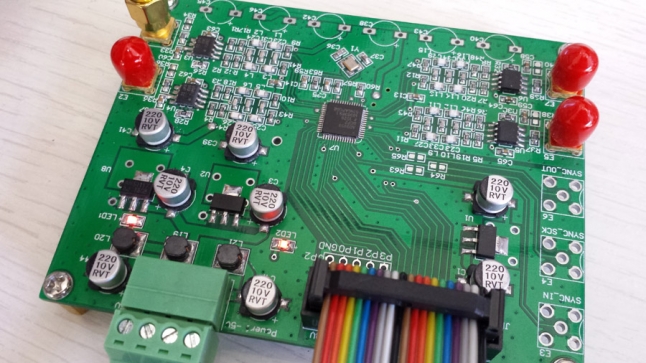Kit de desenvolvimento AD9959 - Gerador de Sinais DDS até 500 Msps de quatro canais
- Publicado em Kits de desenvolvimento
Apresentamos o kit de desenvolvimento da Analog Devices para o circuito integrado AD9959. Trata-se de um gerador de sinais arbitrários DDS de até 500Msps e DACs de 10 bits com quatro canais independentes. Controlável pelo software da própria Analog Devices, o kit de desenvolvimento demonstra todos os incríveis recursos e configurações do AD9959, aplicável em osciladores, instrumentação, geração de clock sincronizado, fonte de RF, entre inúmeras outras.
Especificações Técnicas
The AD9959 consists of four direct digital synthesizer (DDS) cores that provide independent frequency, phase, and amplitude control on each channel. This flexibility can be used to correct imbalances between signals due to analog processing, such as filtering, amplification, or PCB layout-related mismatches. Because all channels share a common system clock, they are inherently synchronized. Synchronization of multiple devices is supported.
The AD9959 can perform up to a 16-level modulation of fre- quency, phase, or amplitude (FSK, PSK, ASK). Modulation is performed by applying data to the profile pins. In addition, the AD9959 also supports linear sweep of frequency, phase, or amplitude for applications such as radar and instrumentation.
The AD9959 serial I/O port offers multiple configurations to provide significant flexibility. The serial I/O port offers an SPI- compatible mode of operation that is virtually identical to the SPI operation found in earlier Analog Devices, Inc., DDS products. Flexibility is provided by four data pins (SDIO_0/SDIO_1/ SDIO_2/SDIO_3) that allow four programmable modes of serial I/O operation.
The AD9959 uses advanced DDS technology that provides low power dissipation with high performance. The device incorporates four integrated, high speed 10-bit DACs with excellent wideband and narrow-band SFDR. Each channel has a dedicated 32-bit frequency tuning word, 14 bits of phase offset, and a 10-bit output scale multiplier.
The DAC outputs are supply referenced and must be terminated into AVDD by a resistor or an AVDD center-tapped transformer. Each DAC has its own programmable reference to enable different full-scale currents for each channel.
The DDS acts as a high resolution frequency divider with the REFCLK as the input and the DAC providing the output. The REFCLK input source is common to all channels and can be driven directly or used in combination with an integrated REFCLK multiplier (PLL) up to a maximum of 500 MSPS. The PLL multiplication factor is programmable from 4 to 20, in integer steps. The REFCLK input also features an oscillator circuit to support an external crystal as the REFCLK source. The crystal must be between 20 MHz and 30 MHz. The crystal can be used in combination with the REFCLK multiplier.
The AD9959 comes in a space-saving 56-lead LFCSP package. The DDS core (AVDD and DVDD pins) is powered by a 1.8 V supply. The digital I/O interface (SPI) operates at 3.3 V and requires DVDD_I/O (Pin 49) be connected to 3.3 V.
Applications
- Agile local oscillators
- Phased array radars/sonars
- Instrumentation
- Synchronized clocking
- RF source for AOTF
Fotos
Itens relacionados (por tag)
- Sintetizador DDS 200MHz Analog Devices AD9959 até 500 Msps de quatro canais
- Tempo de subida e descida do gerador de clock (pulsos) Si5351 150MHz
- Gerador de sinais RF Agilent MXG N5181A 1 GHz
- Kit de desenvolvimento Atenuador RF Programável PE4306 4GHz
- Kit de desenvolvimento Gerador Clock Programável Si5351A 200MHz





